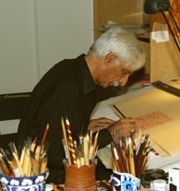Visual Art has many facets which are aesthetically pleasing, conceptually compelling and emotionally stimulating. One of the most important factors in judging a work of art must be an understanding of the artist’s intention. The value of the work depends first on the quality of the artist’s intention and secondly, on the success of the technical realisation of that intention. Language is the means by which we convey ideas. Words are one language but drawing, painting, sculpture and carving are other languages. In writing, the subtle combination of the traditional use of words plus an indefinable personal choice of those is what one would call style.
The historical art of calligraphy painting is as rich and diverse as its present. It has been the main form of Islamic art since the Quran’s revelation in 610 AD. Islamic calligraphy has evolved alongside the religion of Islam and the Arabic language. As it is based on Arabic letters, some call it “Arabic calligraphy”. However, the term “Islamic calligraphy” is a more appropriate term as it comprises all works of calligraphy by Muslim calligraphers from Morocco to China. It has continued to help preserve the beautiful words of the Quran – and the Muslim scribes of the time recorded the Quranic text and many of the Muslims memorised it. Instead of recalling something related to the spoken word, calligraphy for Muslims is a visible expression of the highest art of all: the art of the spiritual world. Calligraphy has arguably become the most venerated form of Islamic art because it provides a link between the languages of the Muslims with the religion of Islam. The holy book of Islam, al-Quran, has played an important role in the development and evolution of the Arabic language, and by extension, calligraphy in the Arabic alphabet. Proverbs and passages from the Quran are still sources for Islamic calligraphy.
Today, Islamic calligraphy is still pious inscription but in the art world, it is also a painterly idiom. Unlike other mediums, it carries with it a spiritual aura which accords it another level of regard and esteem. Amongst the masters of this art form, Rasheed Butt is an eminent and distinguished calligrapher who recently exhibited his masterpieces at Islamabad’s Khaas Gallery. Viewers and art connoisseurs thronged the gallery premises and were delighted to encounter a living legend and his art work. Having begun calligraphy in 1961, Butt has dedicated his life to Islamic calligraphy and its promotion in the arts and culture area. Indeed, calligraphy is an art form that has crossed all racial and dialectal boundaries in the Islamic world, and calligraphers such as Butt have exhibited magnificent pieces all over the world including private collections, museums and historical monuments.
As an art medium calligraphy paintings are broadly divided into two categories. Some artists appreciate the use of traditional scripts supported by design elements, while others prefer to invent their own style of writing as a design pattern. Rasheed Butt’s calligraphic inscriptions fall into four main categories: Quranic – the Holy Quran falls into Chapters (Suras) and Verses (Ayat); Hadith – the Hadith, or Traditions, is the body of sayings attributed to the Prophet (PBUH); Traditional invocations or prayers; and Poetry – both Arabic and Persian. Having showcased 25 pieces of his work mainly in the mediums of gold, ink and watercolour, Butt’s work is a combination of decidedly-traditional texts that blend into contemporary compositions. Butt’s art work is a fusion of the Naskh, Thuluth, Nastaliq and Kufic styles in calligraphy which have been written in an innovative manner in gold. It is an obvious factor that Butt is sensitive to the traditional cultural elements of calligraphic writing. It is his masterly control over the Qalam that lends his imagery a genuine and indisputable feel.
Another noteworthy quality of Rasheed Butt’s works is the serenading illumination. An illuminated manuscript in historical terms is a document in which the text is supplemented with the added element of decoration. While the use of gold is by far one of the most captivating features of illuminated manuscripts, the bold use of varying colors provide multiple layers of dimension to the illumination. Butt is the first person in Pakistan who has meticulously combined illuminations in his work in colours of turquoise, prussian blue and reds. Unfortunately, illumination is a dying art form but has been revived in his unsurpassed imagery. His compositions are dictated by a fluidity of form and evoke a feeling of liberation and calm.
Being the only calligrapher in the world to write in real gold with Qalam; in 1989, Butt was awarded the ‘President’s Pride of Performace’ – the highest civil award in Pakistan. Several publications including books on history of art and architecture feature his work. Having had several solo exhibitions in Pakistan, the West and the Arab world, Butt has received various awards – particularly on a national level.
Being one of the premier calligraphers of Pakistan, Rasheed Butt is an incomparable and culminating individual, an artist par excellence – as most people would identify him as. Knowing him and his majestic imagery and ingenuity is an honour which holds its own splendour.





